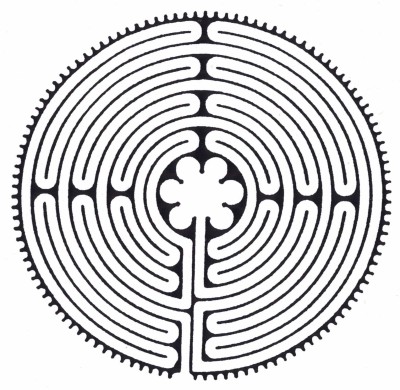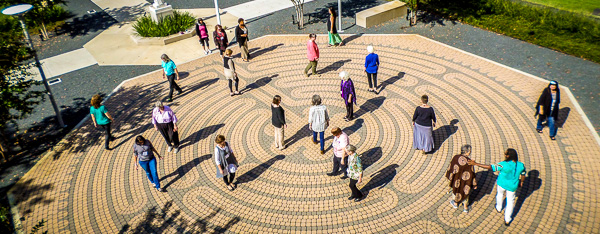Sometimes we are in a rut regarding our prayer. One remedy is to try out a new way of praying. A change might be just the thing to jumpstart a faltering spiritual life and renew our friendship with God. If you have never prayed with a labyrinth, you might explore this centuries-old prayer method, which has become popular again. A labyrinth is different from a maze, which has several possible paths on which you can meet dead ends and get lost. A labyrinth has only one simple path that weaves around within a circle and leads to the center, which represents God. Its four quarters are set around a cross. Praying a labyrinth involves the body as well as the mind.
A bit of history: Christians used to make a vow to make a pilgrimage to Jerusalem. When during the Middle Ages the Crusades and plagues prevented many people from fulfilling this vow, the labyrinth arose as a substitute. Several European cathedrals had labyrinths in their floors. Today only one remains—the forty-two-foot wide labyrinth in the cathedral of Chartres in France.
So how do we pray using a labyrinth? At the entrance to the labyrinth, we quiet down and decide what we will do along the way and out intention. Then we walk along the path to the center. There we pause as long as we like, resting in God’s presence, becoming aware that God is with us, loving us. Then we retrace our steps, symbolizing that we are going back out into the world and bringing God with us. The path stands for the journey of life because as it winds around sometimes it leads us near God and sometimes away from God. If other people are praying the labyrinth, we may pass them going or coming on the way. As we walk the labyrinth, we pray as we wish. We can walk pondering a Scripture verse, repeating a mantra, experiencing a feeling, asking a question, or offering a petition. We can simply walk, paying attention to our thoughts and feelings. The labyrinth can be walked slowly, quickly, or even danced. We can play during this prayer activity or sing. We could walk it barefoot.
Today some labyrinths are constructed outside at churches, shrines, and religious houses. The Episcopal Grace Cathedral in San Francisco, California, has one inside and one outside. If there is an institution near you that has a labyrinth, you might visit it. Some institutions make a large canvas labyrinth available which you might borrow for your parish, church organization, or retreat day. For your personal use, there are labyrinths on cloth that are walked with the finger as well as small metal labyrinths that are traced with a metal stick. Some websites offer labyrinths that can be walked using the mouse!
A simple alternative that you can make for yourself is a labyrinth on a sheet of paper that is “walked” with the finger. You could copy the image here and print it.
If you have prayed with a labyrinth, what was your experience like? Would you recommend it?
BOOK REVIEW: God I s Not Fair and Other Reasons for Gratitude
s Not Fair and Other Reasons for Gratitude
Daniel P. Horan, OFM, Franciscan Media, 133 pp., $15.99
The title of this book, “God Is Not Fair,” is the title of one of its forty-eight chapters or essays. These usually run only two pages and comprise a smorgasbord of reflections on relevant topics. They include clericalism, racism, the death penalty, care for creation, equality in the Church, and mercy. Horan states in his introduction that his reflections are founded on “a belief that we must consider our faith at the intersection of theology, Scripture and culture” and be willing to “to see with new eyes, think with open minds, and care with loving hearts.”
Horan divides his reflections into three parts. In the first part he discusses the Church in the modern world. The second part is composed of his thoughts on selected Gospel passages and resembles a collection of homilies. In the third part he focuses on everyone’s vocation—the call to discipleship.
The essays challenge us to examine our lives in the light of Gospel teaching. Repeatedly Horan exhorts us to walk in the footprints of Jesus. An appealing feature of the book is that it is laced with references to Pope Francis, St. Francis, and the Franciscan way of life.
The themes and thoughts in this book are rooted in Horan’s experiences of writing articles for America magazine, Give Us This Day, and in honor of the Year of Consecrated Life. Although comparatively young, age thirty-two, Horan has a wealth of wisdom to share.











4 Responses
I love walking a labryinth. They had one at the old St. Joseph Retreat house. There was one outside at a small old Church in Cape May, New Jersey. There is one at the Unity Church in Lakewood. We have one at our Unity Church but it is removable and only put done occasionally. But really recommend this.
How nice to know there are so many labyrinths in our city. I find walking one very peaceful.
We were recently on a family vacation in Narragansett, RI, and we took the ferry to Block Island. One of the “attractions” on the island was a labyrinth on a hilltop. We were quite confused as to why this was an “attraction”. Did not realize there was so much history about labyrinths.
Glad I could end your confusion, Vince!